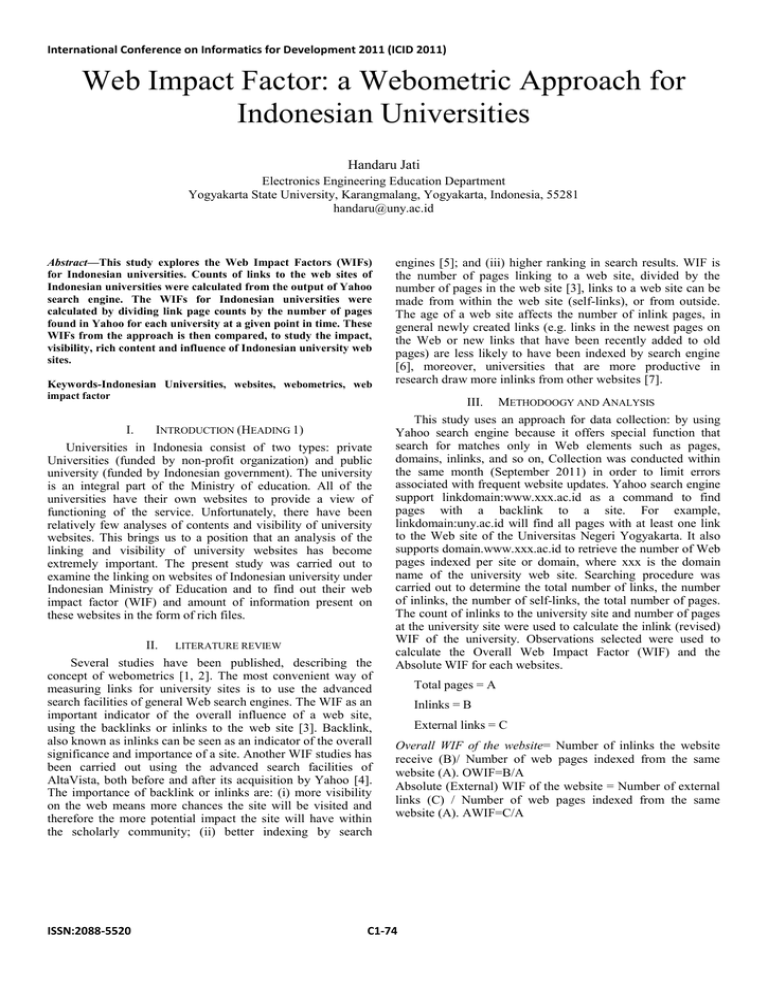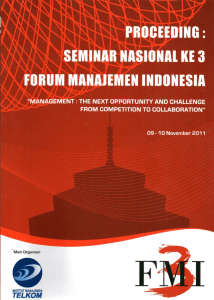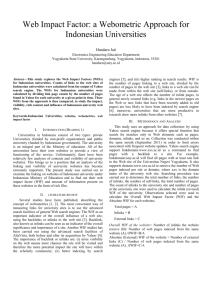Web Impact Factor: a Webometric Approach for Handaru Jati
advertisement

International Conference on Informatics for Development 2011 (ICID 2011) Web Impact Factor: a Webometric Approach for Indonesian Universities Handaru Jati Electronics Engineering Education Department Yogyakarta State University, Karangmalang, Yogyakarta, Indonesia, 55281 handaru@uny.ac.id Abstract—This study explores the Web Impact Factors (WIFs) for Indonesian universities. Counts of links to the web sites of Indonesian universities were calculated from the output of Yahoo search engine. The WIFs for Indonesian universities were calculated by dividing link page counts by the number of pages found in Yahoo for each university at a given point in time. These WIFs from the approach is then compared, to study the impact, visibility, rich content and influence of Indonesian university web sites. Keywords-Indonesian Universities, websites, webometrics, web engines [5]; and (iii) higher ranking in search results. WIF is the number of pages linking to a web site, divided by the number of pages in the web site [3], links to a web site can be made from within the web site (self-links), or from outside. The age of a web site affects the number of inlink pages, in general newly created links (e.g. links in the newest pages on the Web or new links that have been recently added to old pages) are less likely to have been indexed by search engine [6], moreover, universities that are more productive in research draw more inlinks from other websites [7]. impact factor III. I. INTRODUCTION (HEADING 1) Universities in Indonesia consist of two types: private Universities (funded by non-profit organization) and public university (funded by Indonesian government). The university is an integral part of the Ministry of education. All of the universities have their own websites to provide a view of functioning of the service. Unfortunately, there have been relatively few analyses of contents and visibility of university websites. This brings us to a position that an analysis of the linking and visibility of university websites has become extremely important. The present study was carried out to examine the linking on websites of Indonesian university under Indonesian Ministry of Education and to find out their web impact factor (WIF) and amount of information present on these websites in the form of rich files. II. LITERATURE REVIEW Several studies have been published, describing the concept of webometrics [1, 2]. The most convenient way of measuring links for university sites is to use the advanced search facilities of general Web search engines. The WIF as an important indicator of the overall influence of a web site, using the backlinks or inlinks to the web site [3]. Backlink, also known as inlinks can be seen as an indicator of the overall significance and importance of a site. Another WIF studies has been carried out using the advanced search facilities of AltaVista, both before and after its acquisition by Yahoo [4]. The importance of backlink or inlinks are: (i) more visibility on the web means more chances the site will be visited and therefore the more potential impact the site will have within the scholarly community; (ii) better indexing by search ISSN:2088-5520 METHODOOGY AND ANALYSIS This study uses an approach for data collection: by using Yahoo search engine because it offers special function that search for matches only in Web elements such as pages, domains, inlinks, and so on, Collection was conducted within the same month (September 2011) in order to limit errors associated with frequent website updates. Yahoo search engine support linkdomain:www.xxx.ac.id as a command to find pages with a backlink to a site. For example, linkdomain:uny.ac.id will find all pages with at least one link to the Web site of the Universitas Negeri Yogyakarta. It also supports domain.www.xxx.ac.id to retrieve the number of Web pages indexed per site or domain, where xxx is the domain name of the university web site. Searching procedure was carried out to determine the total number of links, the number of inlinks, the number of self-links, the total number of pages. The count of inlinks to the university site and number of pages at the university site were used to calculate the inlink (revised) WIF of the university. Observations selected were used to calculate the Overall Web Impact Factor (WIF) and the Absolute WIF for each websites. Total pages = A Inlinks = B External links = C Overall WIF of the website= Number of inlinks the website receive (B)/ Number of web pages indexed from the same website (A). OWIF=B/A Absolute (External) WIF of the website = Number of external links (C) / Number of web pages indexed from the same website (A). AWIF=C/A C1-74 International Conference on Informatics for Development 2011 (ICID 2011) The indicators used in this study comply with the quantitative aspect of the links and information being provided on a website. These indicators4 are: (i) Size (Number of webpages): This data, however, only provides an insight into quantitative aspect of information on the website and not the quality. Thus, for more rigorous results, other indicators have been used. (ii) Visibility (Total number of inlinks): The number of unique inlinks received by a domain is a measure that represents visibility and impact of the published material, and although there is a great diversity of motivations for linking, a significant fraction works in a similar way as bibliographic citation. (iii) Web Impact Factor (Number of inlinks/Number of webpages), WIF is a measure of the frequency with which a webpage of a website is linked at a given point in time. A higher WIF represents greater reputation of a website. (iv) Rich Files: Number of webpages supporting different file formats, like Portable Document Format (.pdf), post script (.ps), Microsoft Word (.doc), and Microsoft PowerPoint (.ppt). A. Sample Data The recently 20 universities webometric highest rank in 2010 were selected for this study. The list of the studied universities is provided in Table 1. Sources of data includes: Catalogue of Indonesian universities (http://www.webometrics.info/university_by_country_select.a sp.htm) Table 1: List of Indonesian Universities with the corresponding website addresses University Alamat 1 Universitas Gadjah Mada www.ui.ac.id 2 Universitas Indonesia www.itb.ac.id 3 Institut Teknologi Bandung www.unair.ac.id 4 Universitas Airlangga www.undip.ac.id 5 Universitas Diponegoro www.petra.ac.id 6 Universitas Kristen Petra www.gunadarma.ac.id 7 Universitas Gunadarma www.unand.ac.id 8 Universitas Andalas www.its.ac.id Institut Teknologi Sepuluh 9 www.um.ac.id November 10 Universitas Negeri Malang www.unsri.ac.id 11 Universitas Sriwijaya www.ums.ac.id Universitas Muhammadiyah 12 www.usu.ac.id Surakarta 13 Universitas Sumatera Utara www.uii.ac.id 14 Universitas Islam Indonesia www.unikom.ac.id Universitas Komputer 15 www.umm.ac.id Indonesia Universitas Muhammadiyah 16 www.mercubuana.ac.id Malang 17 Universitas Mercu Buana www.binus.ac.id 18 Universitas Bina Nusantara www.umy.ac.id Universitas Muhammadiyah 19 www.uajy.ac.id Yogyakara Universitas Atma Jaya 20 www.ui.ac.id Yogyakarta A comparative analysis of data with regard to the link analysis and presence of information was studied, and its visibility on web was calculated. The number of webpages along with rich files was also examined. Thereafter, interpretations were made based on the analyses. B. Weblink Analysis Table 2 gives number of webpages and number of inlinks for university websites based on the highest webometric rank in 2010. It shows that among all universities, Universitas Sriwijaya had the highest universities number of webpages while Universitas Bina Nusantara had the lowest number of ISSN:2088-5520 webpages. The calculation of WIF requires number of webpages and number of inlinks to a website (given in Table 1). Table 2 shows the WIF for selected universities, last column in table 2 gives web impact factor for ease of ranking. It shows that Universitas Bina Nusantara had the highest impact on web with far more the number of inlinks as compared to the number of webpages on its website. It was followed by Universitas Komputer came next, which also exceeded inlink value of Universitas Bina Nusantara. C1-75 International Conference on Informatics for Development 2011 (ICID 2011) TABLE 2. List of Indonesian Universities with the corresponding number of inlinks, webpage and WIF University A B WIF 1 Universitas Gadjah Mada 3812 12011 0.317 2 Universitas Indonesia 4270 6276 0.680 Institut Teknologi 3 16467 12893 1.277 Bandung 4 Universitas Airlangga 688 1283 0.536 5 Universitas Diponegoro 798 3346 0.238 6 Universitas Kristen Petra 586 182 3.220 7 Universitas Gunadarma 835 2155 0.387 8 Universitas Andalas 2081 6716 0.310 Institut Teknologi 9 983 19640 0.050 Sepuluh November Universitas Negeri 10 224 2081 0.108 Malang 11 Universitas Sriwijaya 408 25788 0.016 Universitas 12 Muhammadiyah 414 1088 0.381 Surakarta Universitas Sumatera 13 548 2552 0.215 Utara Universitas Islam 14 1770 5030 0.352 Indonesia Universitas Komputer 15 1506 266 5.662 Indonesia Universitas 16 597 7120 0.084 Muhammadiyah Malang 17 Universitas Mercu Buana 466 3402 0.137 Universitas Bina 16.88 18 743 44 Nusantara 6 Universitas 19 Muhammadiyah 410 1486 0.276 Yogyakara Universitas Atma Jaya 20 318 1256 0.253 Yogyakarta For the each indicator used in this study, there were a clearly different set of websites of the universities, which achieved the topmost ranks. Thus, different universities excelled from different point of view. There was a universities with as high as 16467 webpages, and a university with a WIF as strong as 16.886. On the other hand there was a university with lowest number of webpages at 318 only, and a WIF of 0.084. Figure 1 depicts that only a quarter or 20 selected universities have above average number of webpages on its website. With the ISSN:2088-5520 total average of 3309 number of webpages per website, majority of universities fall below even that average. FIGURE 1. Average distribution of university websites on the basis of number of webpages. A total average WIF was 1.569, which is not considered satisfactory. Considering the importance of websites, this value should have been high. Figure 2 shows that in meeting average value, WIF is better than the number of webpages. Around 20 per cent of the ministries had above average WIF while 80 per cent still remain below it. FIGURE 2. Average distribution of university websites on the basis of web impact factor. C. Rich Files Also, many of the files were provided in different formats so that the user can access the file in desired format. The comprehensive file-type-wise data regarding the number of rich files has been displayed in Table 3. C1-76 International Conference on Informatics for Development 2011 (ICID 2011) TABLE 3. Number of rich files for selected universities in Indonesia No. Website *.pdf *.ps *.ppt *.doc Total 1 www.umm.ac.id 251,000 47,500 1,650 197,000 497,150 2 www.petra.ac.id 138,000 108,000 138 1,050 247,188 3 www.gunadarma.ac.id 217,000 4,110 3,270 5,860 230,240 4 www.its.ac.id 146,000 1 111 1,500 147,612 5 www.ui.ac.id 84,800 304 3,310 2,680 91,094 6 www.usu.ac.id 83,100 0 160 247 83,507 7 www.unikom.ac.id 77,800 0 52 282 78,134 8 www.ums.ac.id 50,000 8 45 3,630 53,683 9 www.unair.ac.id 42,400 3,190 1,920 1,830 49,340 10 www.undip.ac.id 34,800 0 271 1,350 36,421 11 www.uii.ac.id 34,100 0 47 796 34,943 12 www.unand.ac.id 28,400 3,240 661 1,830 34,131 13 www.binus.ac.id 7,750 0 11,900 13,600 33,250 14 www.um.ac.id 4,950 1,240 725 16,700 23,615 15 www.itb.ac.id 19,500 291 1,120 1,630 22,541 16 www.ugm.ac.id 17,000 0 2,150 2,970 22,120 17 www.mercubuana.ac.id 9,030 660 342 9,690 19,722 18 www.unsri.ac.id 9,480 30 334 2,730 12,574 19 www.umy.ac.id 8,790 568 413 1,360 11,131 20 www.uajy.ac.id 1,190 1,780 642 612 4,224 The rich files need corresponding software for viewing. These readers are mostly the ones who are broadly used all across the world, or can be downloaded from the link given alongside the links to the file itself. Also, many of the files were delivered in different formats, so that the user can access the file in desired format. Then, there was a university with a total of 497150 rich files, and contrastingly there was one with only 4224 files. Thus, the websites of the selected universities proved to be a bag of mixed beans where all variety, ranging from highest to the lowest, can be found. The comprehensive filetype-wise data regarding the number of rich files has been displayed in Table 3. Universitas Muhammadiyah Malang ranked first in rich files, especially from .pdf and .doc file type. Universitas Petra came second. Also, number of .pdf files exceeded the number of .doc and .ppt files. IV. CONCLUTION [1] [2] [3] [4] [5] [6] From the study, it can be concluded that Universitas Sriwijaya had the highest universities number of webpages ranked in with respect to number of webpages. Universitas Bina Nusantara had the highest impact on web with far more the number of inlinks as compared to the number of webpages on ISSN:2088-5520 its website. Universitas Muhammadiyah Malaang was ranked on the top for presence of rich files from the contribution of .doc and .pdf file type. [7] C1-77 REFERENCES G. Eason, B. Noble, and I. N. Sneddon, “On certain integrals of Lipschitz-Hankel type involving products of Bessel functions,” Phil. Trans. Roy. Soc. London, vol. A247, pp. 529–551, April 1955. (references) J. Clerk Maxwell, A Treatise on Electricity and Magnetism, 3rd ed., vol. 2. Oxford: Clarendon, 1892, pp.68–73. I. S. Jacobs and C. P. Bean, “Fine particles, thin films and exchange anisotropy,” in Magnetism, vol. III, G. T. Rado and H. Suhl, Eds. New York: Academic, 1963, pp. 271– 350. K. Elissa, “Title of paper if known,” unpublished. R. Nicole, “Title of paper with only first word capitalized,” J. Name Stand. Abbrev., in press. Y. Yorozu, M. Hirano, K. Oka, and Y. Tagawa, “Electron spectroscopy studies on magneto-optical media and plastic substrate interface,” IEEE Transl. J. Magn. Japan, vol. 2, pp. 740–741, August 1987 [Digests 9th Annual Conf. Magnetics Japan, p. 301, 1982]. M. Young, The Technical Writer's Handbook. Mill Valley, CA: University Science, 1989


